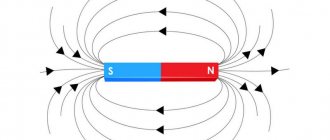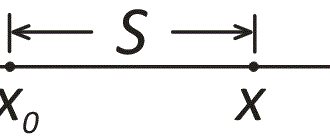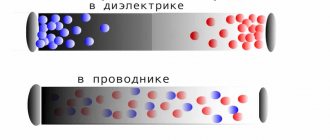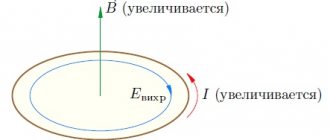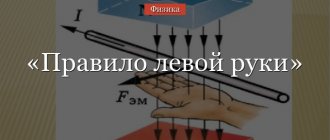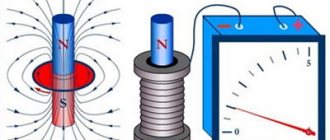Work, power and energy:
We often hear from friends: “I did a lot of work today: I memorized a poem and solved five problems in mathematics.” But from the point of view of physics, no work has been done, even if you memorize an entire poem. What is work in physics?
In physics, the work evaluates what a force caused when acting on a moving body. Let's show this with examples. Look carefully at Figure 216. What do the results of the action of gravity on the ball (Fig. 216, a), the force of gas pressure on a bullet in a pistol (Fig. 216, b) and the elastic force of a compressed spring on the ball (Fig. 216, c) have in common? after burning out the thread? All of these forces cause the acceleration of bodies (ball, bullet, ball), i.e., an increase in the speed of movement.
Can a force acting on a moving body reduce its speed? Throw the ball and watch it move upward (Fig. 217). Now gravity reduces the speed of its movement. In all cases when a force changes the speed of movement (increases or decreases), the force is said to do mechanical work.
Mechanical work is a physical quantity. Its value can be calculated. Let's consider the simplest case: the direction of the force coincides with the direction of movement. For example, a sports sled is being accelerated (Fig. 218). The change in the speed of the sled, and therefore the work to accelerate it, depends on the value of the acting force (the force of the athletes accelerating the sled) and on the distance traveled by the sled. The greater the force and path, the greater the work done. This conclusion is valid for all bodies moving under the influence of force.
Thus, mechanical work is a physical quantity proportional to the force acting on the body and the distance traveled.
Let us denote the work by the letter A. Then, if the direction of the force coincides with the direction of movement of the body,
The SI unit of work is 1 joule (1 J). It is named after the famous English physicist J.P. Joule. One joule is the work done by a force of 1 N along a path of 1 m.
1 joule = 1 newton • 1 meter.
To measure large work, units that are multiples of the joule are used:
In case of small work, submultiple units are used:
From the work formula it follows that if there are forces, but no movement, then there is no work. For example, the force of gravity acting on a ball lying on the table (Fig. 219, a) does not do any work, but in the case of a falling ball (Fig. 219, b) it does.
Strength does not always increase the speed of a body. So, when the ball moves upward (see Fig. 217), gravity slows down its movement. Similarly, when a puck slides on ice, the friction force reduces the speed of the puck. The work of force (gravity, friction) in such cases is considered negative.
But positive and negative work can be performed simultaneously and even be equal in absolute value. In this case, the speed of movement is constant. For example, an electric train moves uniformly on a given section of track. This means that the resultant forces (engine thrust and movement resistance) are equal to zero. Both the traction force and the resistance force do work. Only the work of the traction force and the resistance force. Their sum is equal to 0, i.e.
Main conclusions:
- Mechanical work characterizes the result of the action of a force on a moving body and is proportional to the force acting on the body and the path traveled by the body.
- Forces that accelerate the movement of a body; do positive work.
- Forces that slow down the movement of a body do negative work.
- The SI unit of work is 1 joule (1 J).
An example of solving a problem:
A crane uniformly lifts a concrete slab of mass m = 500 kg from the ground onto one of the floors of a house under construction. In this case, the elastic force of the cable does work A = 100 kJ. Determine to which floor the slab was raised, if the height of one floor is What is the work done by the resultant forces applied to the slab? Take the coefficient equal to
Given:
Solution:
With uniform lifting, the elastic force of the cable is equal to the force of gravity acting on the slab:
Work of elastic force Height of rise - number of floors. Then
From here
Since the motion of the plate is uniform, the resultant of the forces applied to it and the work
Answer: the slab is raised to the 6th floor; work done by resultant forces
What is work in physics - definition and formula
Mechanical work is the amount of energy that must be expended in order for the body to begin a uniformly decelerating motion and cover a certain distance.
In physics, mechanical work is the product of a force that acts on a body and the distance it travels under its influence:
A=F*S
In more complex cases, a third quantity appears in the formula - the cosine of the angle at which the vectors of motion and applied force are located to each other. You can find its value using the formula:
A = F * S * cosA
Energy production
People have long learned to use energy to solve labor-intensive tasks with the help of technology. Potential and kinetic energy are used to do work, such as moving objects. For example, the energy of river water flow has long been used to produce flour in water mills. As more people use technology, such as cars and computers, in their daily lives, the need for energy increases. Today, most energy is generated from non-renewable sources. That is, energy is obtained from fuel extracted from the depths of the Earth, and it is quickly used, but not renewed with the same speed. Such fuels include, for example, coal, oil and uranium, which is used in nuclear power plants. In recent years, the governments of many countries, as well as many international organizations, such as the UN, have made it a priority to study the possibilities of obtaining renewable energy from inexhaustible sources using new technologies. Many scientific studies are aimed at obtaining such types of energy at the lowest cost. Currently, sources such as solar, wind and waves are used to generate renewable energy.
Energy for domestic and industrial use is usually converted into electricity using batteries and generators. The first power plants in history generated electricity by burning coal or using the energy of water in rivers. Later they learned to use oil, gas, sun and wind to generate energy. Some large enterprises maintain their power plants on site, but most of the energy is produced not where it will be used, but in the power plants. Therefore, the main task of energy engineers is to convert the energy produced into a form that allows the energy to be easily delivered to the consumer. This is especially important when expensive or hazardous energy production technologies are used that require constant supervision by specialists, such as hydro and nuclear power. That is why electricity was chosen for domestic and industrial use, since it is easy to transmit with low losses over long distances via power lines.
Transmission pylons near the Sir Adam Beck hydroelectric power station. Niagara Falls, Ontario, Canada.
Electricity is converted from mechanical, thermal and other types of energy. To do this, water, steam, heated gas or air drive turbines, which rotate generators, where mechanical energy is converted into electrical energy. Steam is produced by heating water using heat produced by nuclear reactions or by burning fossil fuels. Fossil fuels are extracted from the depths of the Earth. These are gas, oil, coal and other combustible materials formed underground. Since their quantity is limited, they are classified as non-renewable fuels. Renewable energy sources include solar, wind, biomass, ocean energy, and geothermal energy.
In remote areas where there are no power lines, or where economic or political problems regularly cause power outages, portable generators and solar panels are used. Generators running on fossil fuels are especially often used both in everyday life and in organizations where electricity is absolutely necessary, for example, in hospitals. Typically, generators operate on piston engines, in which fuel energy is converted into mechanical energy. Also popular are uninterruptible power supply devices with powerful batteries that charge when electricity is supplied and release energy during outages.
Florida Power and Light power plant. Port Everglade, Florida, USA. This power plant consists of four blocks and runs on gas and oil.
Energy produced by burning fossil fuels
Fossil fuels are formed in the earth's crust at high pressure and temperature from organic matter, that is, the remains of plants and animals. Basically, such fuel contains a large amount of carbon. When it burns, it releases energy as well as carbon dioxide (CO₂), one of the greenhouse gases. Fossil fuels are the main source of energy at the moment. However, the greenhouse gases released during its use pose a serious threat to the environment and aggravate global warming. Also, the use of this fuel leads to its rapid consumption, and humanity may be left without fuel if it is completely dependent only on fossil raw materials.
Nuclear power plant cooling towers. Photo from the archives of the site 123RF.com.
Atomic Energy
Nuclear energy is one of the alternative types of energy. It is released during a controlled nuclear fission reaction, during which the nucleus of an atom is divided into smaller parts. The energy released during this reaction heats the water and turns it into steam, which drives turbines.
Nuclear power is not safe. The most famous accidents in recent years occurred at the Chernobyl nuclear power plant (NPP) in Ukraine, at the Three Mile Island nuclear power plant in the United States, and at the Fukushima-1 nuclear power plant in Japan. After the Fukushima tragedy, many countries began to reconsider their domestic nuclear energy policies, and some, such as Germany, decided to abandon them. Germany is currently developing a program for the transition to other types of energy supply and the safe closure of existing power plants.
In addition to accidents, there is also the problem of storing spent nuclear fuel and radioactive waste. Some of the spent nuclear fuel is used in weapons production, medicine, and other industries. However, most radioactive waste cannot be used and therefore it is necessary to ensure its safe disposal. Each country that has nuclear power plants stores this waste differently, and many countries have laws prohibiting its import into the country. Radioactive waste is treated so that it does not enter the environment, does not decompose, and is convenient for storage, for example, by making it more compact. After this, they are sent for burial in long-term storage facilities at the bottom of seas and oceans, in geological structures, or in pools and special containers. Storage is associated with problems such as the high cost of processing and disposal, leakage of radioactive elements into the environment, lack of storage space, and the possibility of terrorist attacks at radioactive waste disposal sites.
Nuclear power plant in Pickering, Ontario, Canada
A much safer alternative is to produce nuclear energy through fusion. During this reaction, several nuclei collide at high speed and form a new atom. This happens because the forces that repel nuclei from each other are weaker at a short distance than the forces that attract them. A thermonuclear reaction also produces radioactive waste, but it ceases to be radioactive after about a hundred years, while the waste from a fission reaction does not decay for several thousand years. The fuel required for fusion reactions is less expensive than for fission reactions. The energy costs of thermonuclear reactions currently do not justify their use in the energy sector, but scientists hope that in the near future this will change and nuclear power plants around the world will be able to produce nuclear energy in this way.
How is work measured?
The physical units in which mechanical work is expressed are Joules.
There are different ways to practically measure it, depending on the type of movement produced. In this case, the value of the force in Newtons and the distance in meters are substituted into the work formula. The angle between vectors is measured in mathematical units - degrees.
Kinetic energy
Current work - how is it measured?
This is part of the total energy that determines the energy of movement. In the SI system it is measured in joules (J), in the GHS - in ergs (erg).
How to connect the concept of work with kinetic energy? The formula for kinetic energy is:
Ek = m*v2/2.
In this formula, the physical quantity Ek is equal to 1/2 of the mass of the body multiplied by the speed of this body squared.
Kinetic energy
Next, the work of forces acting on a point using Newton’s 2nd law is displayed. The formula of the law allows us to express force (F) through acceleration (a):
F = m*a,
Where:
- m – body weight;
- a is the acceleration of the body.
Operating with kinematic quantities and paying attention to the formula A = F*s, they try to express the desired relationship.
The case of rectilinear accelerated motion, where speed and displacement can be expressed by the formula:
s = v22-v21/2a,
Where:
- v1 – module of the initial velocity vector (at the beginning of the section);
- v2 – module of the final velocity vector (at the end of the section).
You should substitute the value of the displacement s and F into the work formula:
A = m*a*(v22-v21)/2a = m*v22/2 – m*v21/2.
The minuend or subtrahend displayed in the second part of the resulting equality has the general form:
m*v/2.
This is kinetic energy, it is usually denoted by Ek.
From all this it follows that the work performed on the body by the resultant forces corresponds to the change in Ek.
Worth remembering! When a force presses on a body in the direction of its movement, the work it does is positive, and Ek > 0. When it is applied opposite to the movement of the body, then Ek < 0, and the work is negative.
Newton's second law
Work of friction force
Under the conditions existing on Earth, any moving body is affected by the force of friction, which slows down its movement. Most often this is the friction of the surface on which the object is moving. This is obvious from the fact that when a constant force is applied to a body, its speed will be variable.
Therefore, there must be another force opposing it - and this is the force of friction. If the coordinate system is chosen in the direction of body movement, then its numerical value will be negative.
Renewable Energy
Other alternative forms of energy are solar, ocean, and wind energy. Technologies for producing such energy have not yet been developed to such an extent that humanity can abandon the use of fossil fuels. However, thanks to government subsidies and the fact that they do not cause much harm to the environment, these types of energy are becoming increasingly popular.
Photovoltaic panel
Energy of sun
Experiments on harnessing solar energy began as early as 1873, but these technologies did not become widespread until recently. Solar energy is now growing rapidly, thanks in large part to government and international subsidies. The first solar energy centers appeared in the 1980s. Solar energy is most often collected and converted into electricity using solar panels. Sometimes heat engines are used, in which water is heated by solar heat. As a result, water vapor is formed, which drives the turbogenerator.
Wind turbine at Exhibition Place. Toronto, Ontario, Canada.
Wind energy
Humanity has used wind energy for many centuries. The wind was first used in navigation about 7,000 years ago. Windmills have been in use for several hundred years, with the first wind turbines and wind generators appearing in the 1970s.
Ocean Energy
The energy of tides has been used since the times of Ancient Rome, but people began to use the energy of waves and sea currents only recently. Currently, most tidal and wave power plants are just being developed and tested. The problems are mainly related to the high cost of building such stations and the shortcomings of today's technologies. Portugal, the UK, Australia and the US currently operate wave power plants, but many are still in the pilot phase. Scientists believe that ocean energy will become one of the main areas of green energy in the future.
Tidal turbine at the Canadian Science and Technology Museum in Ottawa
Biofuel
When biofuels are burned, energy is released that plants have converted from solar energy through the process of photosynthesis. Biofuels are widely used both for domestic purposes, such as heating homes and cooking, and as a fuel for transport. Varieties of biofuel - ethyl alcohol and oils - are produced from plant and animal fats. In motor vehicles, biodiesel fuel is used either in pure form or mixed with other types of diesel fuel.
Geothermal energy
The energy in the earth's core is stored as heat. The Earth's crust has been heated to very high temperatures since its formation and still maintains a high temperature today. The radioactive decay of minerals in the Earth's interior also produces heat. Until recently, access to this energy was possible only at the junctions of the earth's layers, in places where hot springs formed. More recently, the development of geothermal wells has begun in other geographic regions in order to begin to use this energy to generate electricity. Currently, the cost of energy obtained from such wells is very high, so geothermal energy is not used as widely as other types of energy.
Niagara River, near the William B. Rankin Power Plant. It was decommissioned in 2009. Niagara Falls, Ontario, Canada.
Hydropower
Hydropower is another alternative to fossil fuels. Hydropower is considered “clean” because, compared to burning fossil fuels, its production is less harmful to the environment. In particular, when generating hydropower, greenhouse gas emissions are negligible.
Hydropower is generated by the flow of water. Humanity has widely used this type of energy for many centuries and its production remains popular due to its low cost and availability. Hydroelectric power plants (HPPs) collect and convert the kinetic energy of river water flow and the potential energy of water in reservoirs using dams. This energy drives hydraulic turbines, which convert it into electricity. Dams are designed to take advantage of the difference in elevation between the reservoir from which the water flows and the river into which the water flows.
Hydroelectric power station named after Robert Moses. Lewiston, New York, USA
Despite the advantages of hydropower, it is associated with a number of problems, such as the harm caused to the ecosphere during the construction of dams. Such construction disrupts ecosystems, and living organisms are cut off from a vital environment in the ecosystem. For example, fish cannot swim upstream to spawn and do not always adapt to new conditions. The public cannot always control the work of energy companies, so the construction of new hydroelectric power plants may result in a humanitarian crisis. An example of such a crisis is the eviction of residents as a result of the construction of the Three Gorges hydroelectric dam in China. During the construction of this hydroelectric power station, the Chinese government evicted more than 1.2 million residents and flooded a huge area, including fields, industrial zones, cities, and towns. Household and industrial waste was washed away and clogged the new reservoir, poisoning plants and fish. Due to the huge amount of water in the reservoir, seismic activity has increased in the region. In 2011, the Chinese government acknowledged this and several other problems.
Positive and negative work
The numerical value of the work performed by a force can become negative if its vector is opposite to the velocity vector.
In other words, force can not only give the body speed to make a movement, but also impede the movement already being made. In this case, it will be called counteracting.
Energy in dietetics and sports
Calories in dietetics
These amounts of sugar, apple, banana and salami contain one food calorie
Energy in sports and nutrition is usually measured in kilojoules or food calories. One such calorie is equal to 4.2 kilojoules, one kilocalorie, or a thousand calories used in physics. By definition, one food calorie is the amount of energy required to heat one kilogram of water by one kelvin. In dietetics, food calories are usually referred to simply as calories, which is what we will do later in this article. This sometimes causes confusion, but usually the reader can tell from the context which units are being referred to. Most foods contain calories. For example, one gram of fat contains 9 calories, one gram of carbohydrates and proteins contains 4 calories each, and alcohol contains 7 calories per gram. Some other substances also contain calories. This energy is released during metabolism and is used by the body to maintain life.
People trying to lose weight often count the calories they eat and subtract the calories they use during exercise. This is done to compare the number of calories not used for physical activity with the daily energy needs of the body in a relaxed state. Typically, to lose weight, the number of calories remaining must be less than what your body needs to keep you at rest. At the same time, doctors and nutritionists consider it dangerous to consume less than 1000 calories per day. The energy needs of the body in a state of rest can be calculated using a formula that takes into account the age, height, and weight of a person. This formula is designed for the average person, but each body stores and uses energy differently, depending on its needs. Therefore, it is not always possible to lose weight, even consuming fewer calories than the body requires according to this formula. The body often adapts to a lack of calories by slowing down its metabolism. As a result, the need for energy decreases, and calculations of a person’s daily energy needs using the formula lead to erroneous results. Despite this, many nutritionists recommend that those wishing to lose weight keep a daily record of their calorie intake.
Photos from the archives of iStockphoto.com
Calorie content
- an important concept in dietetics, which helps determine how energetically beneficial a given food is for the body. Calorie content is calculated by determining the number of calories in one gram of food product. Low calorie foods usually contain a lot of water. It fills the stomach, and a person feels full. As a result, it consumes fewer calories compared to other foods. For example, one hundred gram chocolate bar contains 504 calories. For comparison, such a chocolate bar will take a little less than half a glass. One and a half cups, or 320 grams, of low-fat, skinless, white cooked turkey contains about the same amount of calories. The same amount of calories is contained in 6.3 kilograms of cucumbers, that is, 25 cups. The same example with reduced portions looks like this: About 50 calories are contained in one chocolate candy, a tablespoon of turkey, and six cups of cucumbers. After such a portion of cucumbers, you are unlikely to want to eat, and after one chocolate candy, many will reach for a second and third. High calorie foods are usually unhealthy fatty and sugary foods that should be avoided. It is very useful for people on a diet to know the calorie content of different foods, but do not forget that when creating a menu, it is necessary to take into account not only the calorie content, but also the overall usefulness of each product. To achieve maximum results and improve your health, your diet must be balanced.
The nutritional value
- another useful concept in nutrition. This is the ratio of nutrients and beneficial substances needed by the body, such as vitamins, fiber, antioxidants and minerals, to the energy value of food. Thus, foods with high nutritional value contain a large amount of nutrients for each calorie of the product. Conversely, there are foods with “empty calories,” that is, with very little nutrients and low nutritional value. Alcohol, sweets, chips are some examples of such foods. It is best to exclude them from the diet, or at least limit them, because they do not provide the body with enough nutrients necessary for life.
Calories in sports
Energy is needed by humans and animals to maintain basal metabolism, that is, the body's metabolism at rest. This is the energy to maintain the functioning of the brain, tissues, and other organs. Energy is also needed for everyday physical activity and exercise. With a decrease in fat and an increase in muscle mass, the basal metabolism accelerates, and the need for energy increases. Therefore, any program for improving the body and losing weight should be based not only on reducing fat, but also on increasing muscle mass. To do this, it is important not only to eat right, but also to exercise, especially exercises that help develop muscles.
The amount of energy expended during exercise depends on whether it was aerobic or anaerobic. During aerobic exercise, oxygen breaks down glucose, releasing energy. During anaerobic exercise, oxygen is not used for this process; Instead, energy is produced by the reaction of creatine phosphate with glucose. Anaerobic exercise promotes muscle growth and is short-term and intense. Examples of such sports are sprinting and weightlifting. They cannot be continued for long due to the fact that lactic acid is produced in the process of obtaining energy. Its excess in the blood causes pain, and if a person continues the exercise despite this, he may lose consciousness. Aerobic exercise, on the other hand, can be continued for a long time, since it is less intense and the main thing in it is endurance. Such exercises include long-distance running, swimming and aerobics. With their help, the endurance of the muscles of the heart and respiratory system develops, as well as fat is burned and blood circulation improves.
Café De Paris, Quebec, Canada
Energy and weight loss
Although a lack of energy, relative to expenditure, usually leads to weight loss, this is not always the case, and often after the initial weight loss a person stops losing weight, or even gains weight, despite strict adherence to the diet. This occurs because the body adapts to a lack of calories, for example, as a result of a slower metabolism. In such cases, it is advised to change the exercise routine and menu, for example, temporarily change the type of sport and try to change the daily calorie intake. For example, each day you can consume either more or less calories than the established daily value, or you can set a weekly calorie intake instead of the daily value.
It is very important to remember that the body needs muscle mass to maintain a fast and healthy metabolism. Therefore, healthy diets should be combined with exercise aimed at developing muscles. Fat weighs less than muscle, so when diet and exercise increase muscle mass and decrease fat mass, overall weight increases, despite the fact that the body becomes healthier. Therefore, when improving the health of the body, it is wrong to monitor only weight loss. The ultimate goal is better to set fat loss and muscle development. This applies to both men and women. In addition to weighing, you can measure the percentage of fatty tissue in the body or check for changes in the size of the waist, hips, and other parts of the body where the body stores fat. Nutritionists and trainers advise aiming to reduce the body fat percentage to 14-24% for women and 6-17% for men.
Energy drink Red Bull
Another diet option is to gradually increase or decrease the number of calories in food over a certain period of time. After this, you must always return back to the established norm. Nutritionists also advise diversifying the amount of food at each meal, as well as the main type of food. For example, you could try eating a small carb-rich lunch for lunch the first day, and then eating a large lunch of vegetables and protein the next day. The main thing is that the body does not get used to the same type of food and amount of calories at each meal, and cannot adapt to the lack of energy by slowing down the metabolism. Many diets and exercises aim to speed up your metabolism because it allows the body to burn energy rather than storing it as fat. Therefore, when creating a nutrition and exercise plan, it is necessary to remember this problem of adaptation of the body. It is also important to do anaerobic exercise to increase muscle mass. A system of different exercises to which the body cannot completely get used will also help avoid adaptation.
Energetic drinks
Advertisers often use the word "energy" for advertising purposes. For example, energy drinks are advertised to increase performance and alertness. They usually contain psychostimulants such as caffeine, a lot of sugar, and sometimes vitamins and herbal extracts. Psychostimulants are used to ensure that the body produces the maximum amount of energy in a short period of time. This increases blood flow, blood pressure, pulse, and temperature. More oxygen enters the brain, and feelings of vivacity, strength, and energy increase. Energy drinks, despite their name, should not be consumed during exercise as they disrupt the electrolyte balance in the body. The high content of psychostimulants does increase alertness for a short time, but soon after this a decline and “withdrawal” occurs, reminiscent of the period of withdrawal from sugar, caffeine and alcohol. Many experience other side effects, including nausea, vomiting, headaches, high blood pressure, and insomnia. Doctors recommend avoiding energy drinks. Using the body's natural energy and timely rest is much better for the body than using psychostimulants.
Literature
Author of the article: Kateryna Yuri
Useful or wasted work
A body performing the same action has two meanings of work. The first of them, useful, is calculated using the usual formula.
The second, spent, in its concept does not have a general formula for calculation and is measured practically. This difference between the work done in reality and the work that should have been done in theory is equal to the coefficient of performance - efficiency. It is calculated like this:
Efficiency = A useful / A expended
,
and is expressed as a percentage. Efficiency is always less than 100.
Potential energy
Current density - what is it and how is it measured?
This physical characteristic is part of the total mechanical energy. Describes the location of a body in a force field (source of force). Moreover, this value can provide an assessment only for the entire system. It is useless for characterizing individual points. In this case, it is not the value that is assessed, but its change.
The unit of measurement is J or Erg. The most commonly used graphic symbols are U, Ep, W.
The following types of potential energy are distinguished:
- within the limits of gravity;
- in the area of electrostatic fields;
- in systems of mechanical nature.
For a body located close to the earth's surface, the formula is:
Ep = m*g*h,
Where:
- m – mass;
- g – free fall acceleration (9.8 m/s2);
- h – height of the center of mass of the body above the zero level.
The zero level can be chosen arbitrarily.
An electrically charged material point with potential φ(r→), being in the zone of an electrostatic field, has potential energy Ep. It is calculated using the expression:
Ep = qp* φ(r→),
where qp is the electric charge that this point has.
In mechanical systems, during elastic deformations of a body, its different points interact with each other. Such interactions can be characterized by potential energy.
Elastic deformation can be written as:
Ep = k*(∆x)2/2.
Here k is the stiffness (elasticity), ∆x is the magnitude of the displacement from the equilibrium position.
Power
The average amount of work done per unit of time (second) characterizes such a quantity as power. The formula for calculating it looks like this:
P = A/t
As a work, you can substitute a well-known formula to calculate it, depending on the situation. The answer will be expressed in Watts.
However, with uniform motion, you can use another formula:
P = F * v
By substituting instantaneous speed instead of normal speed, you can get the value of instantaneous power.
General information.
The concept of work is part of the formulation of the first and second laws of thermodynamics.
The work is usually designated by the letter - A. The units of work naturally correspond to the units of energy.
The concept of work is rarely used when solving applied problems. More often they use the concept of power (power of engines, power of technical devices, etc.) defined on the basis of work done per unit of time (energy used per unit of time).
Examples of problem solving
Let's consider several simple problems of finding mechanical work.
Problem 1
What work is done by a lifting mechanism that lifts a ten-kilogram block to a height of 50 meters?
Solution:
In order to lift a body, it is necessary to overcome the force of gravity acting on it. That is, the F with which the block is lifted is equal to the one with which it is attracted to the ground. Since the latter is equal to m * g, then to find the final result you only need one modified version of the standard formula mentioned above: A = S * m * g.
Using simple mathematics, we find the numerical answer:
A = 50 m * 10 kg * 10 N/kg;
A = 5000 J.
Answer: 5000 J.
However, it is not always about gravity.
Problem 2
What work is done by the elastic force when a spring with a stiffness of 10 N/m, compressed by 20 cm, returns to its original state? The system is closed, there are no external forces acting on the spring.
Solution:
First you need to find the elasticity F itself, which does the work. Its formula is F = x * |k|, where x is the length by which the spring is compressed or stretched, and k is its stiffness coefficient. The displacement of the spring is equal to its deformation, and therefore the final formula in this case will look like this: A = S * x * k = x * x * k = x^2 * k.
Next, using elementary calculations, we calculate the answer:
A = (0.2 m)^2 * 10 N/m = 0.04 * 10 = 0.4 J.
Answer: 0.4 J.
But in all problems on this topic, the trajectory of the body’s movement is straight.
Problem 3
Calculate the force acting on the wheel if it takes 10 kJ to complete a full rotation. The diameter of the disk is 40 cm, and the thickness of the tire is 10 cm.
Solution:
In this case, we need to find not A, but F, but this can be done using the same formula. Let's take a point on the surface of the wheel. Let us assume that during rotational motion its vector will be opposite to the vector of force application, which means that the cosine in the formula can again be neglected. Thus, in one revolution of the wheel the point will travel a distance equal to the circumference, which can be calculated as 2πr or πd. The diameter of the circle can be found from the data provided: it is equal to the sum of the rim diameter and twice the tire thickness, that is, 40 cm + 2 * 10 cm = 40 cm + 20 cm = 60 cm = 0.6 m.
Now that we can calculate the distance, we have all the data we need to start finding the force.
The work formula for this case will be: A = F * π * d, then the force, accordingly, can be expressed as F = A / (π * d).
In this case:
F = 10 kJ / (3.14 * 0.6 m) = 10000 J / 1.884 m = ~5308 N.
Answer: 5308 N.
In conclusion, we will solve the most complex version of the problem, which includes everything mentioned above.
Power and power units
When purchasing a car (Fig. 226), a lawn mower, a microwave oven (Fig. 227), etc., a person is interested in their power. It is power that is the passport characteristic of machines and mechanisms. What is power? Why is it so important to know it?
Let's look at an example. A man uses a shovel to dig a hole for a cellar over several days. An excavator (Fig. 228) will dig the same hole in a few minutes. The work is done the same. The same mass of soil rises to the same height. But the speed of work performed by a person and an excavator is different. In a unit of time, an excavator performs many times more work than a person. To describe the speed of work done, power is introduced.
A physical quantity equal to the ratio of work to the period of time during which this work is performed is called power. Power is designated by the letter R.
The SI unit of power is the power at which the force acting on the body does A = 1 J of work in time t = 1 s. This unit of power is called the watt (W) in honor of the English inventor J. Watt. To measure large powers, multiple units are used: hectowatt (gW), kilowatt (kW), megawatt (MW). Note:
For low powers, submultiple units are used - milliwatt (mW), microwatt (µW):
In everyday life, the unit of power kilowatt is often thoughtlessly mistaken for a unit of work. But work from which it follows that the unit of work can only be a kilowatt-hour (kW • h), but not a kilowatt (kW). Let's express power through other units - force and speed. Power but work the way Then
Power is proportional to the force doing work and the speed of movement. Then, at constant power, the lower the speed, the greater the force. That is why the driver, when starting from a stop or climbing a hill (Fig. 229), when great force is required, drives at low speed. Thus, it increases the traction force of the car engine.
Main conclusions
- Power is a physical quantity that characterizes the speed of work.
- The SI unit of power is 1 watt.
- The same power can be obtained either with high speed and low force, or with low speed and high force.
For the curious
In the automotive industry, traditionally, an ancient unit of power is used - horsepower (hp). Using the figure, formulate your own definition of power of 1 horsepower.
Let's write down the connection 1 l. With. and watt: 1 l. With. = 736 W.
In these non-system units, the power of the first Belarusian tractor MTZ-2 (1953) was 37 hp. With. The Belarus-3023 tractor, mastered in 2010, has a 300 hp engine. With. Convert these power signs to SI units yourself and compare them.
An example of solving a problem:
During a physical education lesson, a boy with mass m = 40 kg climbed a rope to a height h = 5.0 m in a period of time t = 10 s. Determine the average power developed by the boy when lifting. Coefficient
Given:
Solution:
When climbing a rope, the muscular strength of the arms works to overcome the force of gravity.
Then
Answer: P = 0.20 kW.
Kinetic energy
Energy is one of the most important and complex concepts. And not only in physics, but also in other sciences. What is kinetic energy?
Let's look at two examples. The puck, hitting the goal net (Fig. 230), bends it. A hammer for driving piles (Fig. 231), falling on a pile, drives it into the ground to a certain depth. To bend the mesh more or drive the pile deeper, the washer and hammer must have greater speed. Both the washer and the hammer did the work. At the same time, the speed of their movement changed (decreased to zero). The work they performed was different, even if we assume that the speeds were the same. But the masses of the hammer and washer are not equal.
If a body is capable of doing work, then it has energy. In physics, the energy of a moving body is called kinetic (from the Greek kinetikos - setting in motion). Kinetic energy is denoted by the letter K (or ) and is measured in SI in the same units as work, i.e. in joules.
The large kinetic energy of moving bodies - a stone, a car, a train (Fig. 232), a meteorite, etc. - means, firstly, that when they were accelerated to a given speed by the accelerating force, a lot of work was done and, secondly, when they When stopping, the braking force will do the same amount of work.
From the examples it follows that kinetic energy depends on the mass of the body and the speed of its movement. What is this dependency?
Experiments show that kinetic energy is directly proportional to the mass of a body and the square of its speed of movement:
Increasing the speed of body movement, for example by 4 times, leads to an increase in kinetics - Please note! ical energy by 16 times. Drivers and pedestrians should always remember this.
Main conclusions:
- Kinetic energy expresses the ability of moving bodies to do work.
- Kinetic energy, like work, is measured in joules.
- The kinetic energy of a body depends on its mass and speed.
- You can change (increase or decrease) the kinetic energy of a body only by doing work (positive or negative).
An example of solving a problem:
The speed of movement of a loaded car with mass m = 4.0 t increased from to along the path s = 25 m. Determine the traction force of the car engine and the work done by this force. Ignore movement resistance.
Given:
Solution:
To increase the kinetic energy from to the traction force had to do work:
But work from here
Answer:
Potential energy
When any body (sleigh, car, etc.) accelerates, it acquires the ability to perform mechanical work—the moving body acquires kinetic energy. What if the body is motionless? Does it have the ability to do work?
Let's conduct two experiments. In the first, we will lift and fasten a weight on a thread above a box of sand (Fig. 235, a). In the second, between the stop and the ball we will place a spring pre-compressed and tied with a thread (Fig. 235, b). Both bodies (weight and spring) are motionless and do not possess kinetic energy. But both the weight and the spring have the ability to do work. To do this, in both cases it is enough to burn the thread. In physics they say that bodies (a raised weight interacting with the Earth and a compressed spring) have potential energy (from the Latin potentia - hidden ability). Potential energy in SI is measured in the same units as work - in joules.
It is important to understand that potential energy does not appear on its own. In these experiments, the weight was raised above the table, the spring was compressed by some force. This means that in order for the body to store potential energy, work must be done. The more the spring is compressed, the higher the body is raised, the greater the potential energy reserve. The bodies presented in Figure 236 already have potential energy. In a springboard it is caused by the deflection (deformation) of the board, in a mousetrap it is caused by the twisting of the spring, in a bow it is caused by a change in the position of the shaft and string. From these and other examples it follows that potential energy is the energy caused by the relative position of interacting bodies or parts of the body (weights and the Earth, arrows and bowstrings, spring links). Potential energy is denoted by the letter P (or).
It is thanks to the potential energy of a compressed (twisted) spring that mechanical watches, time relays for microwave ovens, washing machines, and some children's toys move. The potential energy of the water raised by the dam forces hydroelectric power stations to operate (Fig. 237).
Main conclusions:
- Fixed interacting bodies (a system of bodies) may have the ability to perform mechanical work, and therefore potential energy.
- The value of potential energy depends on the relative position of interacting bodies (body parts).
- Potential energy changes only when work is done.
Potential Energy Calculation
The kinetic energy of a body, depending on its mass and speed, is expressed by the formula This formula is valid both for the planet Earth, rushing at speed in its orbit around the Sun, and for an atom invisible to our eyes. Is there a single formula for calculating potential energy?
Let us consider two cases separately: the potential energy of attraction of a body above the Earth’s surface and the potential energy of a deformed body.
In the first case, the formula for calculating potential energy is easy to derive. If a body of mass m is raised relative to the surface of the Earth to a height h (Fig. 238), then when it falls, the force of gravity can do work:
This is the potential energy of a raised body:
The value of potential energy is relative. Thus, relative to the floor, the potential energy of a lamp (Fig. 239) with a mass m = 1.0 kg, the center of gravity of which is located at a height from the floor, is equal to:
Relative to the ceiling it is equal to:
Therefore, when giving the value of potential energy, it is necessary to indicate the level relative to which it is given - the zero level of potential energy (this could be, for example, the surface of the floor, ceiling, table, etc.).
The situation is much more complicated when calculating the potential energy of a deformed body. We can stretch or compress the spring, bend or twist it (Fig. 240). The spring will have potential energy in each of these cases. And the greater the elastic deformation, the greater the potential energy of the spring. In this example, potential energy will have to be calculated using various formulas. You will learn more about this in 9th grade.
Main conclusions:
- The potential energy of attraction of a body to the Earth depends on the mass of the body and the height of its rise above the zero energy level.
- The value of the body's potential energy depends on the choice of the zero energy level.
- The potential energy of a deformed body depends on the magnitude of the deformation.
An example of solving a problem:
A homogeneous paraffin cube with edge length a = 10 cm lies on the table at a height = 0.80 m from the floor. Determine the potential energy of the cube relative to the surfaces: a) floor; b) table. How much work must be done to lift the cube from the floor to the table? Coefficient
Given:
Solution:
The potential energy of the cube relative to the floor surface (Fig. 241) is determined by the position of its center (point O):
The mass of the cube is then:
Potential energy of the cube relative to the table surface:
The work done to raise the cube to a height is equal to the change in its potential energy. We get:
Answer:
Law of conservation of mechanical energy
Kinetic and potential energy are two types of mechanical energy. Are they related to each other? And if so, what is this connection?
Let's follow the movement of a metal ball thrown upward (Fig. 243). At the lowest point of the trajectory, the force of the hand on the ball imparts kinetic energy to it. The ball moves up. The speed of its movement, and therefore the kinetic energy, decreases. But does kinetic energy disappear without a trace? Rising higher, the ball acquires more and more potential energy (remember: ). At the top point, the speed and kinetic energy of the ball are zero, and the potential energy is maximum. This means that in the example considered, energy is converted from one type (kinetic) to another (potential). When the ball returns back, energy conversion will occur again: with a decrease in height (and potential energy), the speed of the ball (and kinetic energy) increases.
If air resistance is small (and can be neglected), a ball thrown upward returns back with almost the same speed and kinetic energy as at the moment of throwing.
What will be the value of the mechanical energy of the ball at intermediate points? For example, at a height (Fig. 243)? As the ball rises to a height, its kinetic energy decreases, but potential energy appears. What is their sum, i.e., total mechanical energy? This and similar experiments and calculations show that if there are no resistance forces, then the total mechanical energy of a body (system of bodies), equal to the sum of kinetic and potential energies, is conserved. This statement about the constancy of mechanical energy in physics is called the law of conservation of mechanical energy.
If the forces of friction or resistance to movement cannot be neglected, this law does not apply. Let us replace the metal ball in the experiment with a foam block of the same mass (Fig. 244). We will see that even with an initial speed greater than that of a metal ball, it will not rise to the same height and will return back at a noticeably lower speed. The kinetic energy of a puck moving along a horizontal ice surface decreases, but potential energy does not appear in return. Due to the kinetic energy of the puck, work is done against frictional forces.
In conclusion, we note that people have learned to use the phenomenon of transforming energy from one type into another for practical purposes. The energy of falling water powers water mills and hydroelectric power stations. The Republic of Belarus is successfully implementing a state program for the use of river energy. An important role in it is given to such rivers as the Neman and Western Dvina. The Grodno hydroelectric power station with a capacity of 17 MW operates in Neman. The installed capacity of the Vitebsk hydroelectric power station on the Western Dvina is 40 MW.
From ancient times, man began to use the kinetic energy of the wind with the help of a sail (Fig. 245), then began to use it in windmills. In recent years, the construction of wind power plants has begun in our country (Fig. 246). They are unique in that they do not have a harmful effect on the environment. Many countries successfully use the energy of the ebb and flow of the seas and oceans. Tidal power plants have been created there.
Main conclusions:
- Kinetic and potential energies are mutually convertible.
- In the absence of friction forces and resistance to movement, the total mechanical energy of the body (system of bodies) is conserved.
- The law of conservation of mechanical energy is not satisfied if the forces of friction (resistance) cannot be neglected.
- Order solutions to physics problems
An example of solving a problem:
A stone is thrown vertically upward with a speed. At what height from the point of throwing will the kinetic energy of the stone be 4 times less than its potential energy? Neglect the resistance to the movement of the stone. Coefficient
Given:
Solution:
Let us take the zero level of potential energy to be the O - O level passing through the point of throwing the stone (Fig. 247). Means,
Total mechanical energy of the stone at throwing point 1:
Total mechanical energy of the stone at point 2:
According to the condition, this means
Answer:
